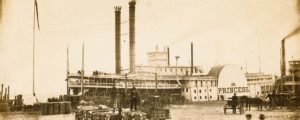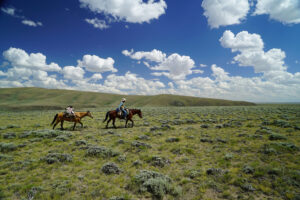In 1882 prospector Hanson H. Barnes found outcrops of silver and lead while roaming the southern flank of the Castle Mountains in Meagher County, Montana Territory. Two years later Barnes got around to recording his remote discoveries, later to become the Princess and Maverick mines.
In 1883 F.L. “Lafe” Hensley, a longtime prospector from Adair, Mo., found silver-carbonated iron ore on the banks of the Musselshell River. He searched the headwaters of every feeder stream and in 1885 located the source 10 miles up Allabaugh Creek at the base of the Castle Mountains. He named his claim the Yellowstone. Lafe then enlisted the aid of his three brothers, and together they discovered the Cumberland (the top producer in the district). The Hensley brothers would go on to have an interest in 37 other properties.
In 1887 more than 1,000 prospectors rushed to the Castle Mountains, staking 1,600 claims. In June, on a grassy slope a half-mile south of the Cumberland, Lafe built the first permanent cabin. Within 60 days he had 200 neighbors, and the town of Castle was soon officially platted and incorporated.
In 1888 The News, the first of Castle’s four newspapers, came off the press. The town grew to support nine stores, two livery stables, two butcher shops, two barbershops, two hotels, 14 saloons, a dance hall, a schoolhouse, a bank, a church, a photo gallery, a doctor’s office, several lawyer’s offices and seven “sporting houses.” Minnie’s was the most popular of the latter.
By 1890 the press was likening Castle to Leadville, Colo., as it sat atop the same type of carbonated ore. However, Castle was remote and lacked a railroad. To offset shipping costs, companies built and operated smelters at the Yellowstone and Cumberland mines, but the cost of bringing in coke to fuel them remained exorbitant. Castle needed a railroad.
In 1892 railroad investor Richard Austin Harlow began laying track from Lombard, hoping to breach the Big Belt Mountains and reach town via Allabaugh Creek. Mine owners in Castle hoarded ore in anticipation and promised Harlow $250,000 on completion of the 150-mile-plus line.
During the Panic of 1893, however, the U.S. government repealed the Sherman Silver Purchase Act and devalued the price of silver. Overnight the mines in Castle closed, and within days the population dropped to fewer than 200. The tracks eventually reached Castle in 1897, four years too late.
By the mid-1930s Castle was down to two residents, septuagenarians Joe Kidd and Joe Martino, and each year the two held an election for mayor, with the runner-up serving as town constable. The vote always ended in a tie, so the Meagher County office in White Sulphur Springs diplomatically alternated its tiebreaker decision each year.
In 1936 Mayor Kidd walked seven miles in a snowstorm to Lennep to secure supplies. On his return, he stopped at Constable Martino’s cabin to warm up, but on the 500-yard last leg to his own cabin he collapsed dead. Martino was unable to negotiate the 20-foot-high drifts to retrieve his friend’s body. He left town the following year for a nursing home.
Legend has it old-timers inspecting the rubble of a saloon in the 1940s discovered a 10-gallon keg of Three-Star Hennessy cognac. They held a party amid the town ruins and invited only former residents. Allotted a half-gallon of brandy each, the group properly toasted the ghosts of Castle.
Terry Halden is president of the Montana Ghost Town Preservation Society and welcomes prospective new members at www.ghosttown.montana.com.
Originally published in the February 2010 issue of Wild West. To subscribe, click here.




